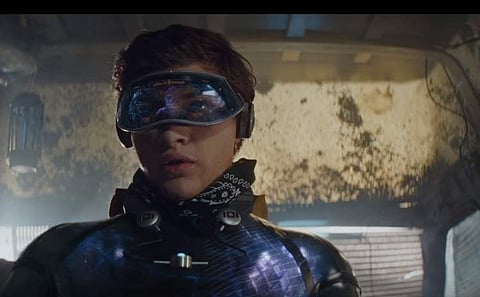

Review
Film: Ready Player One
Director: Steven Spielberg
Cast: Tye Sheridan, Olivia Cooke, Ben Mendelsohn
Rating: 3.5/5
Ready Player One, despite being about a dystopian civilisation that’s happier to live in a virtual world than in the harshness of the real world, isn’t the sort of film to get drawn into discussions over the nature of reality. And yet, it’s impossible not to think about it, for, more than once, Wade Watts (Tye Sheridan) — the hero with an unhealthy obsession for OASIS, the MMOSG world in the film — is belittled for having lived all his life, escaping from the troubles of the real world. Why blame him though? An opening shot shows his various neighbours, all with VR gears on, comically flailing around in their homes. It’s darkly comic.
But what indeed is reality? In Matrix — the film of the last three decades that perhaps most concerned itself with this conversation — Morpheus asks, “What’s real, Neo? How do you define real? If you’re talking about what you can feel, smell, taste and see, ‘real’ is simply electrical signals interpreted by your brain.” In the digitally gorgeous world of OASIS, characters are able to not just find immersion, but can actually feel contact across the body.
The villain gets kicked right where it hurts the most, and upon disconnection from OASIS, limps in pain. It’s as real as it can get, and the only reason you’d disconnect from the world is to take care of your body. Wade has a quick robotic routine in the mornings, as he tries to get done with the human rituals of eating and exercising, so he can go live in the other world. That’s the world where the possibilities are infinite. As Wade narrates at the beginning, “You can skii on the pyramids, you can climb Mount Everest… with Batman.” And yet, eventually, he’s shown to buy that reality is somehow more preferable, because it bloody well be, right? But I never truly bought that that he bought that. It’s probably got to do something with the film’s reluctance to really delve into these topics, save for these occasional detours which I suppose were deemed morally necessary.
So, we have established what Spielberg’s Ready Player One isn’t. What it is though is a eye-poppingly spectacular visual feast, littered with more pop culture references from the 80s than you can keep track of. Right at the beginning of the film, Parzival (name of Wade’s OASIS avatar) flicks an icon from his inventory, and you can’t but look on enchantedly as it unfolds into a customised DeLorean DMC-12 (from the Back to the Future series).
The visuals in your mind, they say, are always more beautiful than they are in real, and that’s always applied to adaptations from books, but Ready Player One is among the few films that break this rule. It’s beautiful to behold all these objects and characters you read about in Ernest Cline’s book. A large part of the film’s enjoyment — much like in the book — is in recognising them, and feeling important about doing so. I spotted Goro from Mortal Kombat, mechagodzilla, Chucky, Kratos from God of War, Nathan Drake from Uncharted… There’s a Jurassic Park reference too, but that’s all you get as far as Spielberg is concerned. It’s strange though, given that he is a big part of the pop culture of 80s. I suppose it must have been a conscious choice to keep his own work out of all the homage.
The film finally gives you reason to believe that all that time spent gaming may not have been in vain, after all. The story itself is a pat in the shoulder of gamers and nerds. The film begins as a game, when James Halliday, after his death, throws a contest open. Then rolls the title… Ready Player One. Let the game begin; let the biggest geek out there win.As with adaptations, there’re quite a few notable departures from the book — some quite useful, some deeply annoying. The first task to find the copper key, for instance, has been reimagined as a racing competition. This is a welcome change from the arcade sequence in the book, and also because Spielberg gives you a visually gratifying sequence, with much chaos, partly unleashed by a dinosaur and King Kong.
One of the biggest disappointments for me — and I suspect for the vast majority of Cline’s book — is the absence of the ‘flicksync’ tasks. In the book, these are where the participant finds himself in the shoes of a prominent character from a popular film. The task is to faithfully reproduce lines and reactions from the film’s scene as it happens. If that’s not a test of obsession with the films of 80s, what is?
Also, in the book, the female lead, Samantha Cook a ka Art3mis (Olivia Cooke) is supposed to be a lot more gorgeous in OASIS than she is in reality. A facial birthmark is supposed to have left her fighting deep feelings of inadequacy. But in the film, this birthmark isn’t nearly as offputting as it should have been. You almost get why Wade would rather stay with her than escape to the OASIS. So long as you’re content identifying all the 80s trivia and revelling in the digital carnival that is Ready Player One, you’ll find yourself quite pleased. If you’re out for depth though, well, this isn’t it. Not unless we’re talking of depth of pop culture knowledge that you can brag about. Oh, did I tell you? I also recognised Sackboy from LittleBigPlanet.